MV Dirona travel digest for Tasmania East Coast 2015

|
Click the travel log icon on the left to see these locations on a map,
with the complete log of our cruise. On the map page, clicking on a camera or text icon will display a picture and/or log entry for that location, and clicking on the smaller icons along the route will display latitude, longitude and other navigation data for that location. And a live map of our current route and most recent log entries always is available at //mvdirona.com/maps/LocationCurrent.html. |
 |
1/1/2015: Sydney to Hobart
Position: -34°32.34'S, 151°6.23'E
We've started to work our way south toward Tasmania. Conditions right now are excellent: warm and sunny, with 10-15 knots behind us from the north. And we're getting a nice push from a favourable current.
|
 |
1/2/2015: Shira
Position: -36°49.32'S, 150°4.49'E
The fishing vessel Shira working a net just north of Eden.
|
 |
1/2/2015: Marine Rescue
Position: -37°4.74'S, 149°54.81'E
Eden Marine Rescue perched on Lookout Point. We'll be stopping in Eden for a couple of days to wait for a weather system to pass through before continuing on to Tasmania.
|
 |
1/2/2015: Multipurpose Jetty
Position: -37°4.31'S, 149°54.43'E
Eden is a thriving commercial fishing town. This is the Multipurpose Jetty, primarily used by fishing vessels.
|
 |
1/2/2015: Victoire
Position: -37°4.29'S, 149°54.48'E
Eden is a popular stopover for boats returning from north from the Sydney-Hobart race. It's also a common place to pull in during the race if conditions become too dangerous or a fault occurs. Victoire placed 15th in line honours this year.
|
 |
1/2/2015: Snug Cove
Position: -37°4.19'S, 149°54.55'E
The view across the Mooring Jetty and Snug Cove from a lookout on Warren's Walk. Dirona is anchored in the distance at the right of the photo.
|
 |
1/2/2015: Killer Whale Museum
Position: -37°4.01'S, 149°54.42'E
The Eden Killer Whale Museum was closed for the day when we went past. A feature display is the bones of "Old Tom", a killer whale who with his pod helped the locals hunt great baleen whales.
|
 |
1/2/2015: Wharfside Cafe
Position: -37°4.33'S, 149°54.58'E
We had an excellent meal of fresh local fish at the Wharfside Cafe.
|
 |
1/3/2015: Morning sun
Position: -37°4.42'S, 149°54.00'E
Looking southwest from the anchorage. With the winds from the north, this was a picturesque and sheltered anchorage. A little swell came through occasionally, but not enough to warrant the flopper-stopper.
|
 |
1/3/2015: Bottom clean
Position: -37°4.41'S, 149°53.98'E
We dove the boat today to clean the bottom. It wasn't in that bad a shape since it's last clean at Lady Musgrave Island, but it still took us 2 1/2 hours each. We definitely do not need a larger boat. We wore our new O'Neill 5mm wetsuits for the first time and were perfectly warm in the 76F water. We're quite happy with them.
|
 |
1/4/2015: En route to Tasmania
Position: -37°13.16'S, 150°3.19'E
We got underway at 6:45 this morning for Tasmania. When we went to bed last night, the forecast wouldn't have conditions sufficiently good until this evening. But when we got up this morning, wind conditions were calm and the new weather reports showed that it might be a little lumpy this morning, but generally good most of the way. If the weather conditions hold, we expect to be arrive at Freycinet Peninsula before noon on Tuesday. The red line shows our intended route--click on the image to see a larger view.
|
 |
1/4/2015: Green Cape
Position: -37°15.80'S, 150°4.41'E
First lit in 1883, the Green Cape Light is the most southern lighthouse in New South Wales. It's also the second tallest in the state, at 95'.
|
 |
1/4/2015: Gabo Island
Position: -37°33.56'S, 149°59.41'E
We're off the coast of Victoria now--this is the rather bleak-looking Gabo Island light.
|
 |
1/4/2015: Conditions
Position: -38°12.01'S, 149°46.44'E
As forecast, we had a few hours of 15-25 SW winds that have since eased off to 10-15. The wind came up surprisingly quickly, and the seas built up a bit, with tight 6-8' waves on the bow and a fair bit of pitching motion. But it wasn't a big deal and we're hardly taking any spray on the windshield now. We expect conditions will continue to improve as we near Tasmania.
|
 |
1/5/2015: Pretty Fly III
Position: -39°10.19'S, 149°26.24'E
We had to alter course twice tonight to avoid oncoming traffic. Nearly a dozen boats, all likely returning Sydney-Hobart race contenders, were heading north on a near-reciprocal course. One was running AIS: Pretty Fly III, who placed 14th in line honours this year.
|
 |
1/5/2015: Sunrise
Position: -39°23.97'S, 149°22.28'E
Conditions are excellent, with 10-15 knots wind from the SE and a low easterly swell. We're nearly halfway to Freycinet Peninsula now and should arrive tomorrow morning. We originally were planning to make our first stop on the way south at Flinders Island, but decided to attend the last two days of Moth Worlds. We'll be flying from Hobart to Melbourne on the first flight on January 15th, returning on the last flight of the day on the 16th. So we're adjusting our stops to what fits between now and when we need to be in Hobart. Moths are 11' foil-equipped racing sailboats capable of upwards of 30 knots. They're incredible to watch. This year's Moth Worlds have a record 150 registrants, including 3 Moth world champions, 8 Olympic medalists, and 15 America's Cup sailors.
|
 |
1/5/2014: Conditions
Position: -40°56.76'S, 148°49.90'E
The winds have dropped further to just 10 knots from the NE with a gentle easterly swell. We've had a wonderfully calm day and expect these conditions to last well through tomorrow.
|
 |
1/5/2015: Entertainment
Position: -40°27.64'S, 149°0.14'E
We all have ways to keep ourselves entertained at sea. One of Spitfire's is to unravel the toilet paper roll.
|
 |
1/6/2015: Moonlight
Position: -41°48.51'S, 148°31.50'E
At 4am, the moon is so bright it appears a spotlight is shining on the boat, and dolphins are chasing our bow. Conditions remain calm, and we're only a few hours out now. We can see the Cape Tourville light flashing at the northern end of Freycinet Peninsula and the light of Bicheno to our west.
|
 |
1/6/2015: Landfall
Position: -42°6.24'S, 148°23.80'E
Approaching Wineglass Bay, our first anchorage in Tasmania. When we left Eden, we were planning to run around Freycinet Peninsula to Coles Bay for our first anchorage, expecting conditions to be too rough to anchor in Wineglass Bay. But conditions were better than forecast, and the anchorage was calm.
|
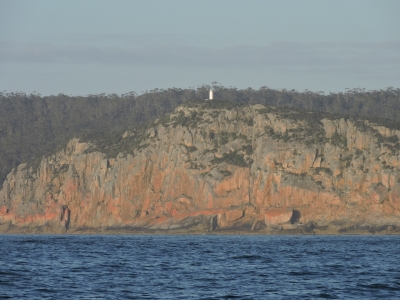 |
1/6/2015: Cape Tourville
Position: -42°7.44'S, 148°23.04'E
The lighthouse perched on the cliff at Cape Tourville. A walking track leads to the lighthouse for sweeping views to sea.
|
 |
1/6/2015: Bow watch
Position: -42°7.99'S, 148°22.75'E
Spitifire out on his traditional landfall bow watch.
|
 |
1/6/2015: Mount Dove
Position: -42°9.91'S, 148°19.25'E
The shoulder of 485m Mount Dove dominates the scene as we approach Wineglass Bay. Mount Dove is the central of five granite mountains that make up the Hazards range.
|
 |
1/6/2015: Wineglass Bay
Position: -42°10.13'S, 148°18.57'E
The scenery as we approach Wineglass Bay is amazing. The 500m Hazard mountains are on the right and the beach at Wineglass Bay is straight ahead.
|
 |
1/6/2015: Ashore
Position: -42°10.49'S, 148°18.66'E
We considered landing in the middle of the beach, but even gentle surf rolls in fairly hard, so we tucked around the sheltered south corner for an easy landing. There we traded rubber boots for hiking boots before setting off on foot. Temperatures are a lot cooler here--in the 60s F rather than the 80s we had in Sydney.
|
 |
1/6/2015: Beach
Position: -42°10.49'S, 148°18.65'E
A beautiful squeaky and soft sand beach rings Wineglass Bay. This is looking north across the bay. Dirona is visible near the saddle between the two mountains (click the image for a larger view).
|
 |
1/6/2015: Wineglass Bay track
Position: -42°9.41'S, 148°17.59'E
A steep track leads from the north end of the beach 636 feet up to the Wineglass Bay Lookout and then back down the other side to a car park. A surprisingly large number of people make the trek down the track to the beach, many with small children or infants. So the trail actually is quite crowded.
|
 |
1/6/2015: Crowds
Position: -42°9.28'S, 148°17.54'E
This is the high season for tourism in Tasmania--the Wineglass Bay Lookout was busy, with more people arriving constantly despite the climb from the parking lot.
|
 |
1/6/2015: View
Position: -42°9.29'S, 148°17.61'E
This is why everyone has made the climb to the lookout: the panoramic view to Wineglass Bay on the left and a Promise Bay on the right. Dirona is the leftmost of the two anchored boats.
|
 |
1/6/2015: Lunch
Position: -42°8.86'S, 148°16.61'E
We followed the Wineglass Bay Track down to the parking lot and picked up the Hazards Beach Track to return to Wineglass Bay. The track had many excellent views into Great Oyster Bay. We stopped for lunch on a bluff with a view to Coles Bay at the right of the photo.
|
 |
1/6/2015: Pocket beach
Position: -42°10.06'S, 148°16.29'E
A small pocket beach at the north end of Promise Bay.
|
 |
1/6/2015: Hazards Beach
Position: -42°10.11'S, 148°16.29'E
Beautiful Hazards Beach rings Promise Bay. The many people on the beach likely were returning to the parking lot from the Wineglass Bay Lookout via Wineglass Bay Beach.
|
 |
1/6/2015: Isthmus Track
Position: -42°10.42'S, 148°16.83'E
We took the Isthmus Track up the sand dunes towards Wineglass bays.
|
 |
1/6/2015: Boardwalk
Position: -42°10.29'S, 148°17.16'E
A boardwalk runs through the marshier sections of the Isthmus Track.
|
 |
1/6/2015: Lemon Rock
Position: -42°10.70'S, 148°21.68'E
Lemon Rock off Cape Forestier. The winds were forecast to climb to 20 knots from the northeast overnight and since we wanted to be in Coles Bay the next day to possibly walk to the Cape Tourville lighthouse, we decided to go early.
|
 |
1/6/2015: Half Lemon Rock
Position: -42°11.46'S, 148°21.84'E
Dramatic Half Lemon Rock dwarfs the commercial fishing boat beside it. The outer coast is rugged, weatherworn and imposing.
|
 |
1/7/2015: Test system
Position: -42°8.26'S, 148°17.68'E
The outdoor LED strip lights were malfunctioning, so James built a test system to investigate. He found excess resistance at one strip, causing dim lights, and found broken wires at another, causing missing colors.
|
 |
1/7/2015: The Hazards
Position: -42°8.28'S, 148°17.68'E
We were planning to walk to the Cape Tourville lighthouse today, but we were fogged in until this afternoon, so stayed on board and got some boat projects done. The is the view to the Hazard mountain range from the anchorage at Cole Bay when the sky finally cleared late in the afternoon.
|
 |
1/7/2015: Sunset
Position: -42°8.29'S, 148°17.69'E
.
|
 |
1/8/2015: Dolphins
Position: -42°17.78'S, 148°11.79'E
Dolphins chased our bow en route to Maria Island.
|
 |
1/8/2015: Ile de Phoques
Position: -42°25.33'S, 148°9.59'E
Caves riddle tiny Ile de Phogues, similar to what we've seen at Dempster Island along Vancouver Island's west coast. One at the tiny bay on the northeast side goes all the way through to the north end. This large one is at the south corner. Phoques means seal in French--several seals were perched on the rocks there.
|
 |
1/8/2015: Ile du Nord
Position: -42°33.48'S, 148°3.40'E
The light on Ile du Nord with the Bishop and Clerk ridge on Maria Island in the background. French explorer Nicolas Baudin named many of the area's features in an expedition in 1802.
|
 |
1/8/2015: Ruins
Position: -42°34.70'S, 148°3.49'E
Maria Island was a convict probation station in the 1800s. These are the ruins of a cement works from the island's industrial era in the 1920s.
|
 |
1/8/2015: L'Austral
Position: -42°35.02'S, 148°2.76'E
The French cruise ship L'Austral was anchored off the island and shuttling passengers ashore.
|
 |
1/8/2015: Deep Hole
Position: -42°40.36'S, 148°3.77'E
The charts show depths of 8-13 feet through most of Shoal Bay. But on the satellite image, you can see what the Tasmanian Anchoring Guide calls the "Deep Hole", with depths around 25 feet.
|
 |
1/8/2015: Falling pressure
Position: -42°40.34'S, 148°3.78'E
We've got a front moving through today--the barometer has fallen from 1022 to 999 in 48 hours. The heavy rainfall is rinsing off the saltwater coating from our Bass Strait crossing.
|
 |
1/8/2015: Freshwater level sensor
Position: -42°40.33'S, 148°3.78'E
The freshwater level sensor stopped working after a failed firmware upgrade, so we installed a spare.
|
 |
1/8/2015: Zincs
Position: -42°40.34'S, 148°3.78'E
James crawled behind the lazarette freezer to replace the pencil zincs in the hydraulic system heat exchanger.
|
 |
1/8/2015: Raw water strainer
Position: -42°40.36'S, 148°3.77'E
One of our raw water intake strainers was cracked and leaking, so we replaced it with Groco strainer (right). The new strainer was not drop-in compatible, but it seems much more durable than the originals (left) so worth the installation hassle.
|
 |
1/9/2015: Arrivals
Position: -42°34.69'S, 148°3.91'E
A ferry-load of passengers arriving at Maria Island National Park. The historic ruins and natural beauty make the park popular.
|
 |
1/9/2015: Commissariat Store
Position: -42°34.69'S, 148°3.91'E
The Commissariat Store, on the right, is the oldest building on the island. It was built in 1828, during the island's convict period (1825-1850). The structure on the left was part of the 1920s cement complex.
|
 |
1/9/2015: Relief map
Position: -42°34.81'S, 148°3.95'E
The Commissariat Store is now a parks information center that includes this relief map.
|
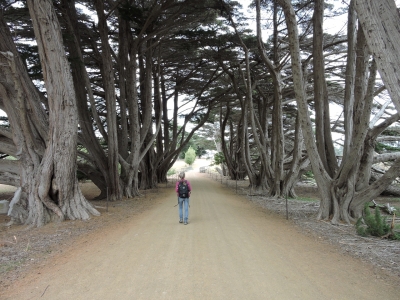 |
1/9/2015: On the road
Position: -42°34.92'S, 148°3.94'E
This tree-lined road led towards the old township of Darlington en route to the Bishop and Clerk track.
|
 |
1/9/2015: Prisoner's barracks
Position: -42°34.88'S, 148°4.15'E
Maria Island was a convict station for repeat offenders from 1825-1832, and then a convict probation station. These are the prisoners Barracks from the 1830s.
|
 |
1/9/2015: Cottages
Position: -42°34.88'S, 148°4.15'E
These cottages date from the 1890s, during the time Dieggo Bernacchi operated a winery on the island.
|
 |
1/9/2015: Cement works
Position: -42°34.70'S, 148°4.74'E
Ruins of the cement works, built in the late 1800s.
|
 |
1/9/2015: Skipping Ridge
Position: -42°34.74'S, 148°4.90'E
The view looking east from Skipping Ridge. Our destination, the Bishop and Clerk peaks, is visible in the far distance on the left.
|
 |
1/9/2015: Ile du Nord
Position: -42°34.97'S, 148°5.13'E
Ile du Nord in the distance, viewed from Skipping Ridge.
|
 |
1/9/2015: Echidna
Position: -42°35.22'S, 148°5.69'E
A spiny echidna was foraging just off the track. Although it looks bothered by us being there, it actually is just digging for food in the ground below him and completely ignoring us.
|
 |
1/9/2015: Nearly there
Position: -42°35.43'S, 148°6.64'E
We're 478 meters up and close to the top as the crow flies. But we still have to climb another 135 meters. Part of the track is a steep path laid through a rock slide. The white posts mark the way.
|
 |
1/9/2015: Bishop and Clerk
Position: -42°35.50'S, 148°6.86'E
The twin dolerite columns in front of Jennifer are called Bishop and Clerk because they resemble a clergyman following a mitre-wearing bishop.
|
 |
1/9/2015: Summit view
Position: -42°35.50'S, 148°6.86'E
This video shows the 360-degree view from 620-meter track summit starting with the view southeast to Mistaken Cape, then going clockwise towards the Darlington jetty and back to the summit with a view northeast to the Bishop and Clerk peaks.
|
 |
1/9/2015: Cemetery
Position: -42°34.61'S, 148°3.93'E
Free settlers were buried in this cemetery at the north end of the island between 1825 and 1942. Convicts and others were buried in unmarked graves elsewhere on the island.
|
 |
1/9/2015: Convict barn
Position: -42°34.63'S, 148°3.92'E
This convict barn was built in 1846.
|
 |
1/9/2015: Farm equipment
Position: -42°34.63'S, 148°3.92'E
19th-century farm equipment inside the convict barn.
|
 |
1/9/2015: Painted cliffs
Position: -42°35.88'S, 148°2.64'E
The striking Painted Cliffs at the west side of the island. The color comes from ground water that percolated down, leaving traces of iron oxides that stain the rock.
|
 |
1/9/2015: Dinghy repair
Position: -42°40.33'S, 148°3.73'E
The dinghy console had loosened because the screws securing it had pulled through the rotting wood floor. James re-attached it with larger screws. He also reattached the bow rails with larger screws--high load and vibration had pulled the screws loose there as well.
|
 |
1/10/2015: The Sisters
Position: -42°58.53'S, 148°0.51'E
Looking north to one of The Sisters formations off Cape Surville. You can see right through this one.
|
 |
1/10/2015: Tasman Arch
Position: -43°2.75'S, 147°57.29'E
The Tasman Peninsula coast is incredibly dramatic with sea caves and arches carved into soaring cliffs. The large arch slightly to the right of center is the Tasman Arch--a short track leads along the cliffs to a viewpoint over this popular tourist attraction.
|
 |
1/10/2015: Superted
Position: -43°7.46'S, 147°59.13'E
Jean and Matt Findlay in Superted were leaving Fortescue Bay as we arrived. We plan to walk a track leading to an overview of the formations they are just passing.
|
 |
1/10/2015: Cape Huay Track
Position: -43°8.42'S, 147°58.11'E
At the trailhead of the Cape Huay Track.
|
 |
1/10/2015: Steps
Position: -43°8.16'S, 147°58.46'E
The track was beautifully built, with sandstone rock steps much of the way.
|
 |
1/10/2015: Fortescue Bay
Position: -43°8.20'S, 147°58.49'E
The track had a nice view back to Fortescue Bay.
|
 |
1/10/2015: Boardwalk
Position: -43°8.71'S, 147°59.19'E
Part of the track with through a bog over a sturdy boardwalk.
|
 |
1/10/2015: Echinda
Position: -43°8.73'S, 147°59.52'E
We saw another Echidna today, this one also digging for food and ignoring us.
|
 |
1/10/2015: Cape Hauy
Position: -43°8.69'S, 147°59.70'E
The track is visible in the distance leading to Cape Hauy.
|
 |
1/10/2015: Lookout
Position: -43°8.38'S, 148°0.30'E
Our destination is where the people are, on the cliff edge just slightly left of center. (Click the image for a larger view).
|
 |
1/10/2015: Steep
Position: -43°8.42'S, 148°0.28'E
We're 400 feet above sea level, but the sheer drop-off makes it feel much higher.
|
 |
1/10/2015: Lunch
Position: -43°8.37'S, 148°0.32'E
We had lunch perched on the cliffs with an amazing view of the formations.
|
 |
1/10/2015: Cape Hauy video
Position: -43°8.36'S, 148°0.32'E
This video shows the sea stacks "Candlestick" and "Totem Pole" between the mainland and Mitre Rock are.
|
 |
1/10/2015: Bilge pump
Position: -43°8.41'S, 147°57.81'E
The bilge pump started running continuously. James found the outlet valve had failed, so replaced it with a spare.
|
 |
1/10/2015: Candlestick and Totem Pole
Position: -43°8.97'S, 148°0.56'E
Looking north to the "Candlestick" and "Totem Pole" sea stacks as we round Cape Hauy. We were planning to overnight at Fortescue Bay, but decided to run to Port Arthur due to a bit of swell, a lot of mosquitoes, and poor cell coverage when we wanted to watch the Seattle Seahawks playoff game the next day,
|
 |
1/10/2015: Cathedral Rock
Position: -43°13.18'S, 148°0.88'E
Cathedral Rock off Cape Pillar.
|
 |
1/10/2015: Flying Fox
Position: -43°13.73'S, 147°59.73'E
The Tasman Island lighthouse, at 900 feet above sea level, is one of the highest in Australia. Built in 1906 and de-manned in 1977, it also was one of the most remote. Goods and people were transferred between ship and shore using a flying fox, a conveyor suspended from an overhead wire. The hut-like structure ashore, about 100 feet above sea level, is the housing for the flying fox. The cable ran several hundred feet to a rock about 25 feet above sea level, possibly the one just at the edge of the picture on the left. The next stage of transport was an engine-driven tramway that ran up the slope behind the hut to 700 feet above sea level. A horse-drawn tramway was the final stage to reach the lighthouse.
|
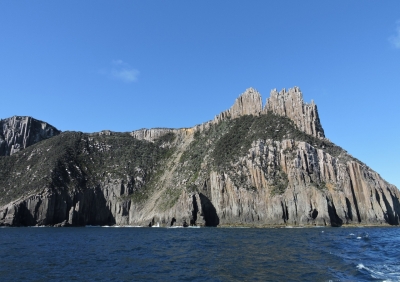 |
1/10/2015: Cape Pillar
Position: -43°13.70'S, 147°59.21'E
We pretty much ran out of superlatives after rounding Cape Pillar.
|
 |
1/11/2015: Maignon Bay Lookout
Position: -43°11.28'S, 147°50.71'E
We'd anchored in Safety Cove to make the short walk across to Maignon Bay. This is the view looking out to the ocean from a lookout above the bay.
|
 |
1/11/2015: Surfers
Position: -43°11.28'S, 147°50.71'E
Maignon Bay is a popular surfing locale. Several surfers were doing flips and other tricks.
|
 |
1/11/2015: Remarkable Cave
Position: -43°11.25'S, 147°50.65'E
The main reason we'd walked over was to visit Remarkable Cave. You can't see it in the picture, but the cave forks at the end, with a second channel on the left. At extreme low tide, you actually can walk all the way through to the ocean.
|
 |
1/11/2015: Maignon Blowhole
Position: -43°11.74'S, 147°51.19'E
We followed a track alonshore to the Maignon Blowhole--this is looking down into the blowhole about 100' above sea level. The seas were fairly calm today, so the blowhole wasn't very active, but you could hear it gurgling below. And the view across to Maignon Bay and out to sea made a nice snack stop.
|
 |
1/11/2015: Raw water leak
Position: -43°10.87'S, 147°51.49'E
There was a slight leak at the foredeck faucet. Unfortunately to replace the o-ring between the faucet and the rest of the plumbing, we had to open up the interior so that we could secure the bottom of the faucet to unscrew it.
|
 |
1/11/2015: Pump maintenance
Position: -43°10.87'S, 147°51.49'E
We carry a Honda WH15X high-powered water pump for emergency water evacuation and fire-fighting. So it's always ready to go, we periodically take it out, test it, run it up to temperature, change the oil and fuel, and shut it back down again.
|
 |
1/11/2015: Seattle Seahawks
Position: -43°10.87'S, 147°51.49'E
Over NFL Gamepass, we watched the Seattle Seahawks beat the Carolina Panthers in the first round of the American football playoffs.
|
 |
1/12/2015: Raw water pump
Position: -43°9.47'S, 147°51.77'E
Continuing to investigate a cycling raw-water pump, we found a second minor leak at the pump and corrected that. But the pump still cycled due to a leaking pressure valve. We replaced the pump and it's now back to cycling only when used.
|
 |
1/12/2015: Hydraulics leak
Position: -43°9.48'S, 147°51.75'E
The forward thruster pressure guage O-ring was leaking for the third time. We can't see any issues with the sealing surfaces so we assume it is an O-ring size problem. We tried a slightly larger size this time and so far it's not leaking.
|
 |
1/12/2015: Port Arthur
Position: -43°8.85'S, 147°51.05'E
Port Arthur was a penal settlement from 1830 to 1877, and included a large community for military personnel and freeholders. This model shows the extent of the buildings in the 1800s. Many of the buildings have been preserved, and the site is now one of Tasmania's top tourist destinations.
|
 |
1/12/2015: Penitentiary
Position: -43°8.94'S, 147°51.09'E
The four-story penitentiary housed 136 prisoners of 'bad character' on the bottom two floors, with bunk space for 480 better-behaved prisoners on the top floors.
|
 |
1/12/2015: Separate Prison
Position: -43°8.89'S, 147°50.83'E
Port Arthur included a "Separate Prison". These were designed to provide psychological punishment by keeping prisoners completely separated, often hooded, with no ability to see or communicate with each other. This was actually viewed as a form of treatment, but the negative side-effects were many.
|
 |
1/12/2015: Parish
Position: -43°8.91'S, 147°50.83'E
The parish in the Separate Prison was built with folding walls to form cubicles where prisoners stood inside and could not see each other. This was one of the few places in the Separate Prison where prisoners were allowed to make any noise--they learned to communicate with each other undetected by singing their sentences to the tune of the hymns.
|
 |
1/12/2015: Church
Position: -43°8.71'S, 147°50.90'E
1,100 people attended compulsory services at the church each Sunday. Like most buildings in Port Arthur, this was built with convict labour, predominately from the nearby Point Puer Boy's Prison.
|
 |
1/12/2015: The Dockyard
Position: -43°8.74'S, 147°51.31'E
The shipyard at Port Arthur operated only for 15 years, but during that time 16 large decked vessels and 150 small boats were built here.
|
 |
1/13/2015: Cape Raoul
Position: -43°14.65'S, 147°46.97'E
Cape Raoul forms a dramatic headland on the run between Port Arthur and Hobart.
|
 |
1/13/2015: Helm seat
Position: -43°7.68'S, 147°32.23'E
We occasionally wish we had two helm seats, and sometimes would like three.
|
 |
1/13/2015: Antarctic
Position: -42°53.20'S, 147°19.99'E
Hobart is a major center for Antarctic research.
|
 |
1/13/2015: History
Position: -42°53.20'S, 147°19.93'E
Hobart was established in 1804 and is Australia's second oldest city. The city is full of well-preserved historic buildings with over 90 in the National Trust.
|
 |
1/13/2015: Moo brew
Position: -42°53.20'S, 147°19.97'E
Enjoying a Tassie Moo Brew at one of the outdoor restaurants in Salamanca market.
|
 |
1/14/2015: Rain
Position: -42°53.56'S, 147°20.12'E
When we walked past this run-off yesterday, it was pretty much dry. Now it's a torrent, and we don't get the impression it rained particularly long or hard for Hobart.
|
 |
1/14/2015: Maritime museum
Position: -42°52.95'S, 147°19.91'E
Hobart has a good maritime museum detailing the city's ship-building and maritime industries, from whaling and transport to pleasure cruising and Incat high-speed catamarans.
|
 |
1/14/2015: Cruise ships
Position: -42°52.97'S, 147°19.92'E
The two cruise ships that came in today tower over the city. (The stern of the second is just visible on the left of the photo.)
|
 |
1/15/2015: Moth Worlds
Position: -38°20.63'S, 144°45.13'E
We left Dirona in Hobart and flew to Melbourne to attend the final two days of the Moth World Championships in Sorrento. Read more ...
|
 |
1/17/2015: Valve adjustment
Position: -42°53.87'S, 147°20.08'E
The generator valves need adjusting every 1,000 hours. We've got 3,745 hours on it now, and it's been 1,001 since the last adjustment.
|
 |
1/18/2015: Mt. Wellington
Position: -42°53.71'S, 147°14.32'E
David Fincham drove us to the top of 4,170' (1,271m) Mt. Wellington. The climate was surprisingly different up there--average temperatures are 51F (10.5C) lower than in Hobart and icy winds frequently blow. The highest steady winds in Tasmania were recorded here at 94kts. It wasn't that windy when we were up there, but the winds were strong enough you had to lean into them. The view to Hobart and the River Derwent was incredible. In the photo, downtown Hobart is roughly in the center, with the Tasman Bridge just to the left and the Hobart airport in the distance beyond the hills. Dirona is moored at the Royal Yacht Club of Tasmania, right of Hobart and just left of the rightmost prominent tower at the water's edge. (Click the image for an enlarged view.)
|
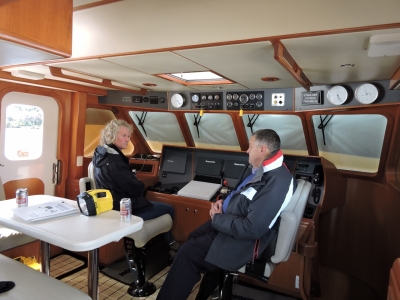 |
1/18/2015: Speedbird
Position: -42°49.63'S, 147°18.15'E
Before dinner, David Fincham gave us a tour of Speedbird, his beautifully maintained Nordhavn 57. In the Mt. Wellington photo, Speedbird is moored in the cove just right of the Bridgewater Bridge (the leftmost of the two bridges across the River Derwent).
|
 |
1/20/2015: Superbowl-bound
Position: -42°53.87'S, 147°20.08'E
Seattle Seahawks defensive end Michael Bennett bicycled around the stadium following the Seahawks 28-22 overtime win against Green Bay to advance to the Superbowl. The finish was incredibly exciting. The Seahawks had played poorly for much of the game, were scoreless at the end of the half, and were down 19-7 with 4 minutes left in the game. Defeat looked certain. But with luck, skill and some trick plays, they staged a comeback and scored 21 points in under 8 minutes.
|
 |
1/20/2015: Royal Yacht Club of Tasmania
Position: -42°53.87'S, 147°20.08'E
We're moored at the Royal Yacht Club of Tasmania. Moorage is available closer to town, but security is better here for leaving the boat while we flew to Melbourne. We haven't spent much time around the docks since arriving, so we walked around a bit this afternoon.
|
 |
1/20/2015: Berth
Position: -42°53.87'S, 147°20.08'E
Several Sydney-Hobart race contenders are moored at the yacht club. We're berthed next to TransPac 52 Cougar, that took 13th in line honours in 2014.
|
 |
1/20/2015: Alive
Position: -42°53.87'S, 147°20.08'E
Alive was another Sydney-Hobart boat at the yacht club. It took 5th in line honours in 2014. We'd seen Alive hauled out in Brisbane, under its previous name of Black Jack.
|
 |
1/20/2015: On guard
Position: -42°53.87'S, 147°20.08'E
Spitfire guarded the boat as we walk the docks.
|
 |
1/21/2015: Fueling
Position: -42°53.90'S, 147°19.98'E
We topped off our fuel before leaving Hobart. We'd only used 600 of our 1,750-gallon capacity (2,300 out of 6,624 liters) since fueling in Sydney. But it's nice to have the tanks full so we can cruise Tasmania without constraints.
|
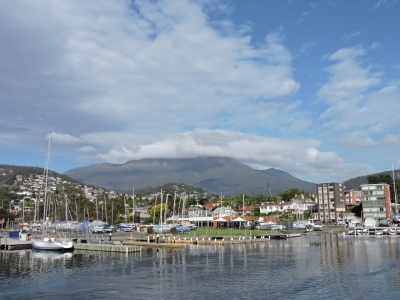 |
1/21/2015: Mt. Wellington
Position: -42°53.98'S, 147°20.48'E
A final view to 4,170' Mt. Wellington as we head south.
|
 |
1/21/2015: Quarantine Bay
Position: -43°7.25'S, 147°20.13'E
Quarantine Bay had a number of boats inside already, so we anchored in Simmonds Bay a little farther east and ran the dinghy back to the public dock at Quarantine Bay.
|
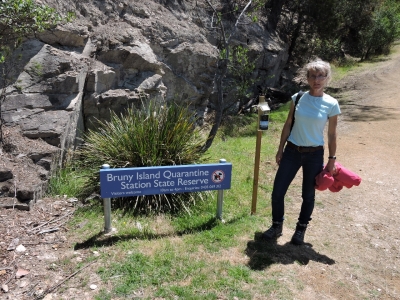 |
1/21/2015: Bruny Island Quarantine Station
Position: -43°7.25'S, 147°20.13'E
A quarantine station operated on Bruny Island from 1884 through 2002. The property is now a state reserve and open for self-guided walking tours.
|
 |
1/21/2015: Plant quarantine
Position: -43°7.15'S, 147°19.83'E
The Bruny Island Quarantine Station included a plant quarantine facility between the 1950s and 1986. This is the greenhouse where plants were observed, sometimes for up to two years, to ensure no pests or diseases were brought into Tasmania.
|
 |
1/21/2015: Superted V
Position: -43°7.54'S, 147°14.94'E
Jean and Matt Findlay had just hauled out their Beneteau 57 Superted V at Kettering, so we stopped by to say hello. Like Jennifer, Jean is height-challenged, but anyone would look small next to Superted's huge rudder and keel.
|
 |
1/21/2015: Westwind of Kettering
Position: -43°7.63'S, 147°15.17'E
Nordhavn 40 Westwind of Kettering was moored at the Kettering marina.
|
 |
1/21/2015: Bruny Island Ferry
Position: -43°7.63'S, 147°15.42'E
We stopped off for a drinks on the deck of the Mermaid Cafe by the Bruny Island ferry terminal. Two ferries run each hour, and they're surprisingly busy with this one carrying two decks of cars.
|
 |
1/21/2015: Crayfish pots
Position: -43°7.63'S, 147°15.42'E
This fishboat below the Mermaid Cafe was stacked with traditional wooden crayfish pots made from tea trees.
|
 |
1/21/2015: Oysters
Position: -43°7.63'S, 147°16.57'E
Oysters thrive here, judging by the growth on the docks.
|
 |
1/21/2015: Aquaculture
Position: -43°8.18'S, 147°18.87'E
We've passed several large aquaculture facilities around Tasmania, with pretty large fish jumping inside.
|
.web.jpg) |
1/21/2015: Simon Calleia
Position: -43°7.91'S, 147°21.35'E
We'd seen Simon Calleia's Outer Reef 630 Jinsei a few times since arriving in Tasmania. Simon also was anchored in Simmonds Bay and he and his daughter stopped by for a visit on Dirona.
|
 |
1/22/2015: Simmonds Bay
Position: -43°7.89'S, 147°21.35'E
Looking north across Jinsei to Simmonds Bay. The more common anchorage is tucked into the little lagoon to our south, but we preferred the swing room of the outer anchorage.
|
 |
1/22/2015: Seals
Position: -43°11.46'S, 147°16.83'E
We've started seeing lots of seals sunning in the water.
|
 |
1/22/2015: Emperor Gum Moth
Position: -43°21.95'S, 147°12.05'E
We found this large Emperor Gum Moth rather firmly attached to our scuba tank in the cockpit. The moth is native to Australia, and common in the Sydney area, but less so farther south. What looks like snow covering it is marine-board dust. We'd cut one of the bilge inspection hatches in half to allow partial access without removing the items stowed above, and only noticed the moth during cleanup.
|
 |
1/23/2015: Cape Bruny Lightstation
Position: -43°29.28'S, 147°8.71'E
We landed the dinghy at Lighthouse Beach and walked the road to the Cape Bruny Lightstation.
|
 |
1/23/2015: Lighthouse Bay
Position: -43°29.31'S, 147°8.70'E
Cape Bruny has wonderful views up and down the ruggeded exposed coast. This is looking east across Lighthouse Bay to West Cloud Head with The Friars off Tasman Head visible in the distance on the right.
|
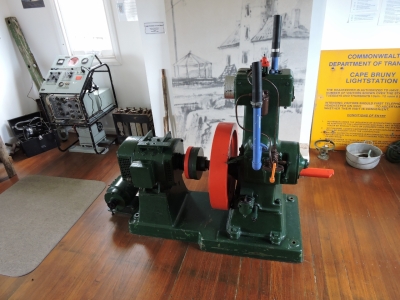 |
1/23/2015: Museum
Position: -43°29.36'S, 147°8.67'E
When first lit in 1838, the Cape Bruny Lighthouse was the third lighthouse in Tasmania and the fourth in Australia. At the time, ship's captains preferred rounding southern Tasmania en route to Sydney instead of passing through the dangerous Bass Strait and would call in to Hobart via D'entrecasteax Channel. The light was built following three 1835 shipwrecks, most notably the convict transport ship George III, with 134 lives lost. In 1996, the light was replaced by a nearby solar-powered light. A small but interesting museum details the light's history and contains many artifacts from it's 158 years of service.
|
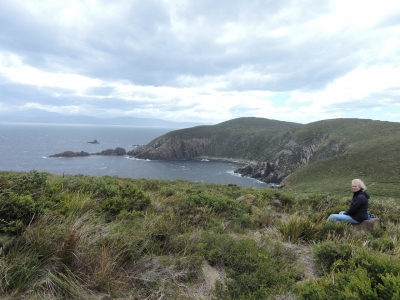 |
1/23/2015: Quiet Bay
Position: -43°29.45'S, 147°8.53'E
We had lunch overlooking Quiet Bay northwest of Cape Bruny. It was much colder on the other side--we left Lighthouse Beach feeling a little warm in T-shirts and jeans, but needed a windbreaker over a fleece jacket on this side of the island.
|
 |
1/23/2015: Lighthouse
Position: -43°29.47'S, 147°8.54'E
The lighthouse is constructed of rubblestone (irregularly-sized, rough stone) and the walls are incredibly thick--perhaps four feet across. It would have to be strong to have survived the big storms along the southern Tasmania coast.
|
 |
1/23/2015: Courts Island
Position: -43°29.54'S, 147°8.32'E
A small track led from behind the lighthouse to Courts Bay on the west side of Cape Bruny. We stopped at the bluff just above the beach, for great views along the windswept coast and to Courts Island off the point.
|
 |
1/23/2015: Steering
Position: -43°27.43'S, 147°9.54'E
The steering wheel on the dinghy had come loose from the console and the only way to tighten it was to take the steering wheel off. So we used a puller to pull it off and tightened the rotary steering assembly.
|
 |
1/24/2015: Hospital Bay
Position: -43°9.67'S, 146°58.53'E
At anchor in Hospital Bay at Port Huon.
|
 |
1/24/2015: Fish food
Position: -43°9.67'S, 146°58.53'E
Huge bags of fish food were on the Port Huon jetty, ready for transport to the fish farms.
|
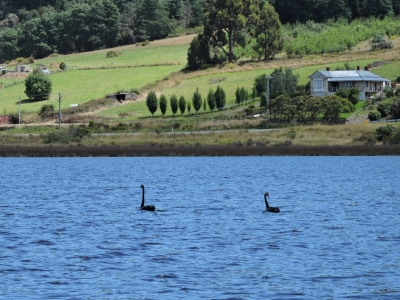 |
1/24/2015: Huon River
Position: -43°6.80'S, 147°0.07'E
The tranquil Huon River runs through farmland on one side and Egg Island wetlands on the other. The river is uncharted north of Port Huon, but we only rarely saw depths less than 7' in the dinghy at low tide, so higher tides are recommended for deeper-draft vessels.
|
 |
1/24/2015: Wooden Boat Center
Position: -43°5.15'S, 147°0.89'E
Several beautiful wooden boats were moored outside the Wooden Boat Center in Franklin.
|
 |
1/24/2015: Vineyards
Position: -43°4.84'S, 147°1.14'E
Tasmania has an established wine industry--we've seen covered vineyards like this along the coast south of Hobart.
|
 |
1/24/2015: Boat House Cafe
Position: -43°2.04'S, 147°2.89'E
We had an excellent lunch in Huonville, perched over the water at the Boat House Cafe. The Huonville riverfront has nice walkways and parks, and was popular on this sunny Saturday.
|
 |
1/24/2015: Rapids
Position: -43°0.92'S, 147°0.39'E
We continued upriver past the Huonville Bridge and managed to reach the second set of rapids before being stopped by insufficient water.
|
 |
1/24/2015: Huon Jet
Position: -43°1.02'S, 147°0.16'E
While near the upriver rapids, the Huon Jet shot past us downriver, showing that with a jet boat, speed, and sufficient driving talent, the rapids are traversable.
|
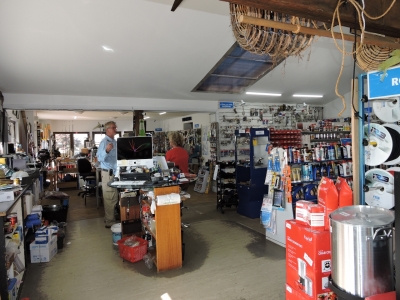 |
1/24/2015: Franklin Marine
Position: -43°5.21'S, 147°0.80'E
We stopped off in Franklin on our way back to Port Huon. In the well-stocked Franklin Marine chandlery we met Laurence Burgin, who did service work for superyachts and some Nordhavns when he was based in Sydney. We had a great time talking boats with him.
|
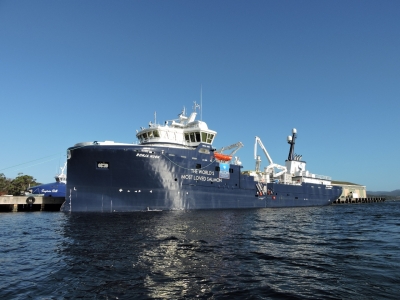 |
1/24/2015: Ronja Huon
Position: -43°9.56'S, 146°58.51'E
The 75-meter well-boat Ronja Huon had arrived in Port Huon while we were gone. The boat is designed for transporting fish from pens to Huon Tasmania's harvest facility and for bathing fish in freshwater to kill microorganisms that can sicken or kill the salmon. It's an incredibly well-rigged and seaworthy-looking vessel. We were definitely suffering from crane envy in studying it.
|
 |
1/24/2015: Sass
Position: -43°9.33'S, 146°57.55'E
We finished the day with an excellent salmon dinner on the deck at Sass restaurant overlooking the Kermandie Marina.
|
 |
1/26/2015: Huon River
Position: -43°4.95'S, 147°0.97'E
We ran the dingy into Franklin this morning to catch a bus back to Hobart. We'd gotten there a little early, so took a walk down the Huon River. This is the view looking back downriver towards Franklin from the main road. We took the river walk visible at the lower right of the photo back into town.
|
 |
1/26/2015: Tassielink
Position: -43°5.38'S, 147°0.63'E
Tassielink runs buses throughout Tasmania. The one-hour ride from Franklin to Hobart passed quickly, with great views of the Huon River and the Huon Valley, and a sweeping view to Hobart as we neared the city. The return trip was slightly longer because the bus stopped Cygnet en-route, but that gave us a chance to see the east side of the Huon River, and a bit of Cygnet.
|
 |
1/26/2015: Aurora Australis
Position: -42°52.85'S, 147°20.47'E
We'd returned to Hobart for the day to tour the Australian icebreaker Aurora Australis. Read more ...
|
 |
1/26/2015: Tasting paddle
Position: -42°53.21'S, 147°19.95'E
After our tour, we sampled some great Aussie beers over delicious burgers at Jack Greene in the Salamanca district.
|